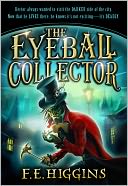
Hector, the main character, spends the book seeking vengeance on the eyeball collector, whose evil ways caused Hector's father's demise. Meanwhile, Hector supports himself as a carnival riddle-master, answering riddles for a penny. This career was one of the best parts of the book, and had my son eagerly waiting for me to look up from the page with the next riddle. Some were new to me, some old, and some had us figuring out the problems together. It was a pity when Hector abandoned this job to more vigorously pursue the revenge business, which ended up sinking in a morass of morality anyway.
The villains were delightfully colorful, the good guys earnestly good, but the framing devices weakened the strength of the book, wrapping the tension in a cool cloth. Some of the stories are narrated in letters, which in turn are read by some other person who I pretty much forgot about by the end of the story. Somehow this book links up with others by Higgins, which might explain the purpose of these exterior figures, but the end result is that I'm not all that tempted to go hunt them down.
I'll leave this around for my fifth grader, although I suspect that since I already read him all the riddles he'll consider it spoiled. He'd be more likely to track down the other books. Hey, I just looked this book up in the library catalog, and nine branches shelf this in Teen Fiction (Y), while my library has it in Children's Fiction (J). The characters are definitely older, but I agree with my librarians that the single toned moral vision makes more sense to pre-adolescents. Teens nowadays want more gray in their books.
No comments:
Post a Comment